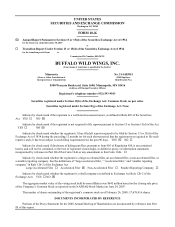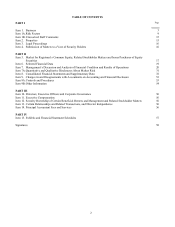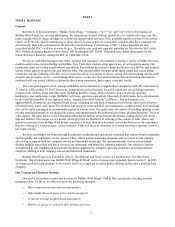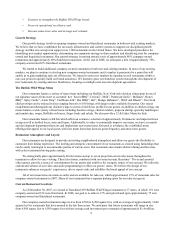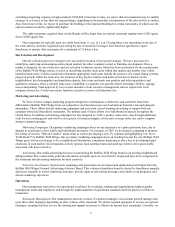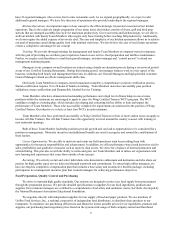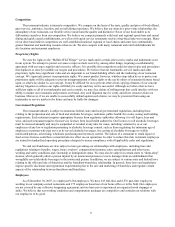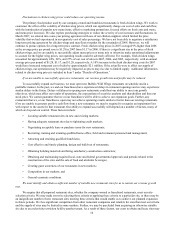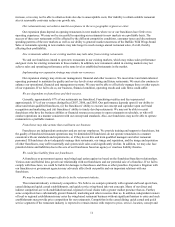Buffalo Wild Wings 2007 Annual Report Download - page 10
Download and view the complete annual report
Please find page 10 of the 2007 Buffalo Wild Wings annual report below. You can navigate through the pages in the report by either clicking on the pages listed below, or by using the keyword search tool below to find specific information within the annual report. 10
Fluctuations in chicken wing prices could reduce our operating income.
The primary food product used by our company-owned and franchised restaurants is fresh chicken wings. We work to
counteract the effect of the volatility of chicken wing prices, which can significantly change our cost of sales and cash flow,
with the introduction of popular new menu items, effective marketing promotions, focused efforts on food costs and waste,
and menu price increases. We also explore purchasing strategies to reduce the severity of cost increases and fluctuations. In
March 2007, we entered into a one-year pricing agreement with one of our chicken suppliers which limited the price
volatility that we had experienced in our quarterly cost of sales percentage. We have not been able to negotiate a satisfactory
long-term pricing agreement for chicken wings and may float at market for the remainder of 2008. However, we will
continue to pursue options for a long-term price contract. Fresh chicken wing prices in 2007 averaged 9% higher than 2006
as the average price per pound rose to $1.28 in 2007 from $1.17 in 2006. If there is a significant rise in the price of fresh
chicken wings, and we are unable to successfully adjust menu prices or menu mix or otherwise make operational adjustments
to account for the higher wing prices, our operating results could be adversely affected. For example, fresh chicken wings
accounted for approximately 24%, 24%, and 27% of our cost of sales in 2007, 2006, and 2005, respectively, with an annual
average price per pound of $1.28, $1.17, and $1.20, respectively. A 10% increase in the fresh chicken wing costs for 2007
would have increased restaurant cost of sales by approximately $2.1 million. If the avian flu were to affect our supply of
chicken wings, our operations may be negatively impacted, as prices may rise due to limited supply. Additional information
related to chicken wing prices is included in Item 7 under “Results of Operations.”
If we are unable to successfully open new restaurants, our revenue growth rate and profits may be reduced.
To successfully expand our business, we must open new Buffalo Wild Wings restaurants on schedule and in a
profitable manner. In the past, we and our franchisees have experienced delays in restaurant openings and we may experience
similar delays in the future. Delays or failures in opening new restaurants could hurt our ability to meet our growth
objectives, which may affect our results of operations, the expectations of securities analysts and shareholders and thus our
stock price. We cannot guarantee that we or our franchisees will be able to achieve our expansion goals. Further, any
restaurants that we, or our franchisees, open may not achieve operating results similar or better than our existing restaurants.
If we are unable to generate positive cash flow from a new restaurant, we may be required to recognize an impairment loss
with respect to the assets for that restaurant. Our ability to expand successfully will depend on a number of factors, many of
which are beyond our control. These factors include:
• Locating suitable restaurant sites in new and existing markets;
• Having adequate restaurant sites due to tightening credit markets;
• Negotiating acceptable lease or purchase terms for new restaurants;
• Recruiting, training and retaining qualified home office, field and restaurant personnel and management;
• Attracting and retaining qualified franchisees;
• Cost effective and timely planning, design and build-out of restaurants;
• Obtaining building materials and hiring satisfactory construction contractors;
• Obtaining and maintaining required local, state and federal governmental approvals and permits related to the
construction of the sites and the sale of food and alcoholic beverages;
• Creating guest awareness of our restaurants in new markets;
• Competition in our markets; and
• General economic conditions.
We must identify and obtain a sufficient number of suitable new restaurant sites for us to sustain our revenue growth
rate.
We require that all proposed restaurant sites, whether for company-owned or franchised restaurants, meet our site-
selection criteria. We may make errors in selecting these criteria or applying these criteria to a particular site, or there may be
an insignificant number of new restaurant sites meeting these criteria that would enable us to achieve our planned expansion
in future periods. We face significant competition from other restaurant companies and retailers for sites that meet our criteria
and the supply of sites may be limited in some markets. Further, we may be precluded from acquiring an otherwise suitable
site due to an exclusivity restriction held by another tenant. As a result of these factors, our costs to obtain and lease sites may

